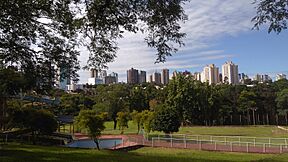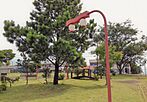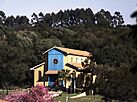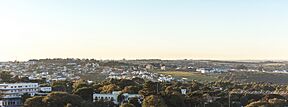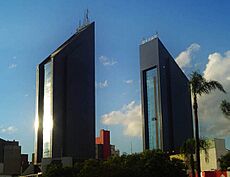Cascavel facts for kids
Quick facts for kids
Cascavel
|
|||
|---|---|---|---|
|
Municipality
|
|||
| Municipality of Cascavel | |||
|
|
|||
|
|||
| Nickname(s):
Capital of the West Mercosur Metropolis |
|||
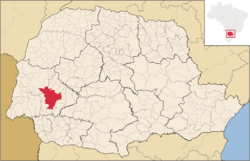
Location in Paraná
|
|||
| Country | |||
| Region | South | ||
| State | |||
| Founding | March 28, 1928 | ||
| Emancipation | November 14, 1951 | ||
| Area | |||
| • Municipality | 2,101.074 km2 (811.229 sq mi) | ||
| • Metro | 10,562.37 km2 (4,078.15 sq mi) | ||
| Elevation | 781 m (2,562 ft) | ||
| Population
(2022)
|
|||
| • Municipality | 348,051 | ||
| • Density | 165.65385/km2 (429.0415/sq mi) | ||
| • Metro | 552,097 | ||
| • Metro density | 52.27018/km2 (135.37915/sq mi) | ||
| Time zone | UTC-3 | ||
| Postal code |
85816-000
|
||
| Area code(s) | (+55) 45 | ||
| HDI (2010) | 0.782 – high | ||
Cascavel is a city in the state of Paraná, Brazil. It is the fifth largest city in the state by population. In 2022, about 348,051 people lived there. The city is about 491 kilometers (305 miles) from Curitiba, which is the state capital.
Cascavel is a fairly new city. It was planned carefully, so it has wide streets and well-organized neighborhoods. It covers an area of about 2,100 square kilometers (811 square miles). Cascavel is an important center for trade and business in the Mercosul region, which is a group of South American countries working together. It is also the main city in the Cascavel Metropolitan Area.
The city sits on a high flat area called a plateau, about 781 meters (2,562 feet) above sea level. It is located in western Paraná, not too far from the borders of Paraguay and Argentina.
Contents
What Does Cascavel Mean?
The name Cascavel means "rattlesnake" in Portuguese. The word comes from an old Latin word, "cascabus," which means "bubbling water."
There's a story about how the city got its name. Long ago, a group of settlers were camping in the area. They woke up to a rattling sound. They soon realized they had set up their camp right next to a rattlesnake! This event gave the place its unique name.
History of Cascavel
Early Days and Yerba Mate
The western part of Paraná was first home to the Caingangue natives. Later, in 1557, the Spanish arrived.
The current city of Cascavel began to form in the late 1910s. People from different backgrounds, including caboclos (people of Indigenous and European descent) and descendants of Slavic immigrants, started to settle there. This was during a time when erva mate (a type of tea) was very popular.
The village officially started on March 28, 1928. A man named José Silverio de Oliveira, also known as "Nho Jeca," bought some land. This land was at a crossing point for many trails used by ervateiros (people who collected erva mate), drovers (people who moved animals), and soldiers. Nho Jeca opened a warehouse there. His business helped attract more people and investments to the area.
In the 1930s and 1940s, many settlers from southern Brazil moved to the village. These were often descendants of Polish, German, and Italian immigrants. They started logging, farming, and raising pigs. The village grew and became an official district in 1938.
Even before it was a district, Cascavel was on military maps as early as 1924. The city of Foz do Iguaçu officially recognized the village as Cascavel in 1936. However, a local church leader tried to change its name to "Aparecida dos Portos," but the people living there did not like the new name, so it didn't stick.
The Wood Cycle
After the erva mate business slowed down in the 1930s, the area entered the "cycle of wood." This meant that cutting down trees became the main economic activity. Many families from Santa Catarina and Rio Grande do Sul moved to Cascavel, especially Polish, German, and Italian settlers. These groups became a big part of the city's population.
As the native forests were cut down, the land became available for farming. Today, agriculture is a very important part of Cascavel's economy.
Becoming a Municipality
Cascavel became its own municipality on November 14, 1951. This meant it was no longer part of Foz do Iguaçu. For many years, people debated if this was the right date, because the first city government only started on December 14, 1952. But in 2010, a law confirmed November 14, 1951, as the official date.
Modern Development
By the late 1970s, the wood industry ended. Cascavel then started to focus on manufacturing and growing its farming and service industries. In less than 60 years, Cascavel changed from a simple stop for travelers to one of the biggest cities in western Paraná. It is now a major economic center in southern Brazil.
City Leaders (Mayors)
Here are some of the people who have served as mayor of Cascavel:
| Name | Years in Office |
|---|---|
| José Neves Formighieri | 1952 to 1956 |
| Helberto Edwino Schwarz | 1956 to 1960 |
| Octacílio Mion | 1960 to 1964 |
| Odilon Correia Reinhardt | 1964 to 1969 |
| Octacílio Mion | 1969 to 1973 |
| Pedro Muffato | 1973 to 1977 |
| Jacy Miguel Scanagatta | 1977 to 1983 |
| Fidelcino Tolentino | 1983 to 1988 |
| Salazar Barreiros | 1989 to 1992 |
| Fidelcino Tolentino | 1993 to 1996 |
| Salazar Barreiros | 1997 to 2000 |
| Edgar Bueno | 2001 to 2004 |
| Lísias Tomé | 2005 to 2008 |
| Edgar Bueno | 2009 to 2016 |
| Leonaldo Paranhos | 2017 to 2024 |
Geography and Climate
Cascavel's Weather
Cascavel has a humid subtropical climate. This means it has warm, wet summers and mild winters. The average temperature each year is about 21°C (70°F). The highest temperatures can reach around 28°C (85°F). The city gets a lot of rain, with about 1965 mm (77 inches) falling each year.
| Climate data for Cascavel, elevation 760 m (2,490 ft), (1976–2005 normals, extremes 1973–1998) | |||||||||||||
|---|---|---|---|---|---|---|---|---|---|---|---|---|---|
| Month | Jan | Feb | Mar | Apr | May | Jun | Jul | Aug | Sep | Oct | Nov | Dec | Year |
| Record high °C (°F) | 34.4 (93.9) |
34.1 (93.4) |
33.9 (93.0) |
32.2 (90.0) |
31.0 (87.8) |
28.0 (82.4) |
28.9 (84.0) |
33.2 (91.8) |
35.4 (95.7) |
34.9 (94.8) |
36.6 (97.9) |
36.4 (97.5) |
36.6 (97.9) |
| Mean daily maximum °C (°F) | 28.6 (83.5) |
28.3 (82.9) |
28.2 (82.8) |
25.8 (78.4) |
22.4 (72.3) |
20.4 (68.7) |
20.9 (69.6) |
22.7 (72.9) |
24.0 (75.2) |
26.2 (79.2) |
27.8 (82.0) |
28.3 (82.9) |
25.3 (77.5) |
| Daily mean °C (°F) | 23.1 (73.6) |
22.7 (72.9) |
22.2 (72.0) |
19.9 (67.8) |
17.0 (62.6) |
15.1 (59.2) |
15.2 (59.4) |
16.7 (62.1) |
18.0 (64.4) |
20.2 (68.4) |
21.8 (71.2) |
22.8 (73.0) |
19.6 (67.2) |
| Mean daily minimum °C (°F) | 19.1 (66.4) |
19.0 (66.2) |
18.3 (64.9) |
16.0 (60.8) |
13.3 (55.9) |
11.5 (52.7) |
11.3 (52.3) |
12.6 (54.7) |
13.6 (56.5) |
15.8 (60.4) |
17.1 (62.8) |
18.6 (65.5) |
15.5 (59.9) |
| Record low °C (°F) | 9.8 (49.6) |
9.2 (48.6) |
6.7 (44.1) |
3.6 (38.5) |
−0.4 (31.3) |
−0.8 (30.6) |
−4.2 (24.4) |
−1.9 (28.6) |
0.2 (32.4) |
4.0 (39.2) |
7.2 (45.0) |
10.8 (51.4) |
−4.2 (24.4) |
| Average precipitation mm (inches) | 191.9 (7.56) |
177.6 (6.99) |
141.5 (5.57) |
167.2 (6.58) |
192.3 (7.57) |
131.1 (5.16) |
110.2 (4.34) |
107.1 (4.22) |
159.0 (6.26) |
224.9 (8.85) |
181.7 (7.15) |
187.5 (7.38) |
1,972 (77.63) |
| Average precipitation days (≥ 1.0 mm) | 14 | 13 | 12 | 10 | 10 | 10 | 8 | 8 | 10 | 12 | 11 | 12 | 130 |
| Average relative humidity (%) | 77 | 79 | 75 | 74 | 76 | 77 | 73 | 69 | 69 | 70 | 68 | 73 | 73 |
| Mean monthly sunshine hours | 224.3 | 193.7 | 216.0 | 202.3 | 196.5 | 183.9 | 209.7 | 202.8 | 179.0 | 203.7 | 223.9 | 226.4 | 2,462.2 |
| Source 1: Empresa Brasileira de Pesquisa Agropecuária (EMBRAPA) | |||||||||||||
| Source 2: IDR-Paraná (precipitation days and sun 1973–1998) | |||||||||||||
Who Lives in Cascavel?
The people of Cascavel come from many different backgrounds. Here's a look at the main groups:
| Ethnicity | Percentage |
|---|---|
| White | 70.15% |
| Mixed | 26.25% |
| Black | 2.59% |
| Asian | 0.88% |
| Indigenous | 0.27% |
How Cascavel's Population Grew
Cascavel has grown a lot since it was founded. In its early decades, the population increased very quickly. Over time, some smaller towns became separate from Cascavel, which slightly slowed down its growth.
| Year | Population | Growth |
|---|---|---|
| 1950 | 404 | |
| 1960 | 39,598 | 9,701% |
| 1970 | 89,921 | 127.08% |
| 1980 | 163,459 | 81.78% |
| 1991 | 192,990 | 18.07% |
| 2000 | 245,369 | 27.14% |
| 2010 | 286,172 | 16.63% |
| 2022 | 348,051 | 21.6% |
Economy
Cascavel is very important for farming in Paraná. It produces about 26% of all the cereals in the state. The main crops grown here are soybeans, wheat, corn, rice, cotton, and beans. The city is also a big producer of poultry (chickens), pigs, and cattle.
Here's how different parts of the economy contribute to Cascavel's total production:
- Farming and raising animals: 5.95%
- Industry (factories): 16.63%
- Services (like shops, hospitals, and banks): 77.42%
The main types of factories in Cascavel process food, make chemicals, work with metals, and produce drinks.
There is also a railway line that connects Cascavel to the port of Paranaguá.
Transportation
Cascavel is in a great location for travel. It's connected by seven major roads, with four of them being interstate highways. This makes it a necessary stop for people traveling by road to the Iguazu Falls in Foz do Iguaçu. It's also a key route to neighboring countries like Argentina and Paraguay.
People traveling from the south to Mato Grosso and Mato Grosso do Sul, or from the northwest to Santa Catarina, Rio Grande do Sul, and Uruguay, often pass through Cascavel. It's also on the way for those heading west to the state capital, Curitiba, or to the beaches and seaports on the coast.
The city also has its own airport, the Regional West Airport. This airport was named the best regional airport in Brazil in both 2022 and 2023.
Universities
Cascavel is an important place for college students. It has a state university, and in recent years, many private universities have also opened branches in the city. This makes Cascavel a growing hub for students.
Universities in Cascavel
- Universidade Estadual do Oeste do Paraná
- Universidade Paranaense
- Federal Institute of Paraná - Cascavel campus
Sport
Cascavel is home to the Autódromo Internacional de Cascavel - Zilmar Beux, which is a famous racing track. It hosts exciting races like the Copa Truck, Stock Car Brasil, Campeonato Brasileiro de Turismo, and the Mercedes-Benz Challenge.
The city also has one of the best futsal (a type of indoor soccer) clubs, Cascavel Futsal Clube. This team has won the Futsal Libertadores Cup twice!
For association football (soccer), the local teams are FC Cascavel and Cascavel Clube Recreativo. In the past, there was also a team called Cascavel Esporte Clube. All these teams play at the Estádio Olímpico Regional Arnaldo Busatto.
See also
In Spanish: Cascavel para niños


